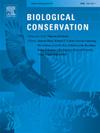保护犯罪化与中国不断演变的野生动物制裁
IF 4.4
1区 环境科学与生态学
Q1 BIODIVERSITY CONSERVATION
引用次数: 0
摘要
刑法仍然是环境治理和保护中无处不在的一部分。然而,越来越多的人质疑在保护中过度定罪的风险。还有人呼吁保护动物从犯罪学中学习更多东西,因为政策试图控制对社会正义和生物多样性的影响。本研究通过对中国野生动物刑事立法近期(2020 - 2022年)重大立法变化的理论法律分析,探讨了保护野生动物刑事化的争论。从表面上看,这些改革似乎是广泛扩大了刑事定罪,实际上反映了更细微的反应,在严重犯罪和轻微犯罪之间建立了更明显的区别。我们采用渔网的类比来讨论这种分歧,这种分歧造成了阈值的变化,这些阈值决定了哪些行为实际上是犯罪行为,决定了犯罪的严重程度,从而确定了相应的惩罚。这在很大程度上是通过引入货币门槛制度实现的,该制度引入了一种标准化的方法,将不同物种的货币价值作为界定刑事犯罪的一种方式。这些变化说明了立法起草的复杂性,以解决和平衡生物多样性保护,社会正义和社会经济利益,以及理论法律分析对保护犯罪和保护设计的辩论的重要性。本文章由计算机程序翻译,如有差异,请以英文原文为准。
Conservation criminalisation and China's evolving wildlife sanctions
Criminal law remains a ubiquitous part of environmental governance and conservation. However, there is increasing interrogation of the risks of over-criminalisation in conservation. There are also calls for conservation to learn more from criminology, as policies seek to navigate impacts on social justice and biodiversity. This study explores the conservation criminalisation debate through a doctrinal legal analysis of significant, recent (2020−2022) legislative changes in China's wildlife criminal legislation. These reforms which, on the surface, seem like widely expanded criminalisation, actually reflected more nuanced responses that have created more pronounced distinctions between serious and minor offences. We employed the fishing net analogy to discuss this bifurcation that created changes to the thresholds that determine what actions are actually criminalised and that determine the severity of crimes and thus define the corresponding penalties. Much of this was achieved through the introduction of a monetary threshold system that introduced a standardised approach to placing monetary values on different species as a way to define criminal offences. These changes illustrate the complexity of legislative drafting to address and balance biodiversity conservation, social justice and socio-economic interests, and the importance of doctrinal legal analysis to both debates on conservation criminalisation and conservation design.
求助全文
通过发布文献求助,成功后即可免费获取论文全文。
去求助
来源期刊

Biological Conservation
环境科学-环境科学
CiteScore
10.20
自引率
3.40%
发文量
295
审稿时长
61 days
期刊介绍:
Biological Conservation is an international leading journal in the discipline of conservation biology. The journal publishes articles spanning a diverse range of fields that contribute to the biological, sociological, and economic dimensions of conservation and natural resource management. The primary aim of Biological Conservation is the publication of high-quality papers that advance the science and practice of conservation, or which demonstrate the application of conservation principles for natural resource management and policy. Therefore it will be of interest to a broad international readership.
 求助内容:
求助内容: 应助结果提醒方式:
应助结果提醒方式:


